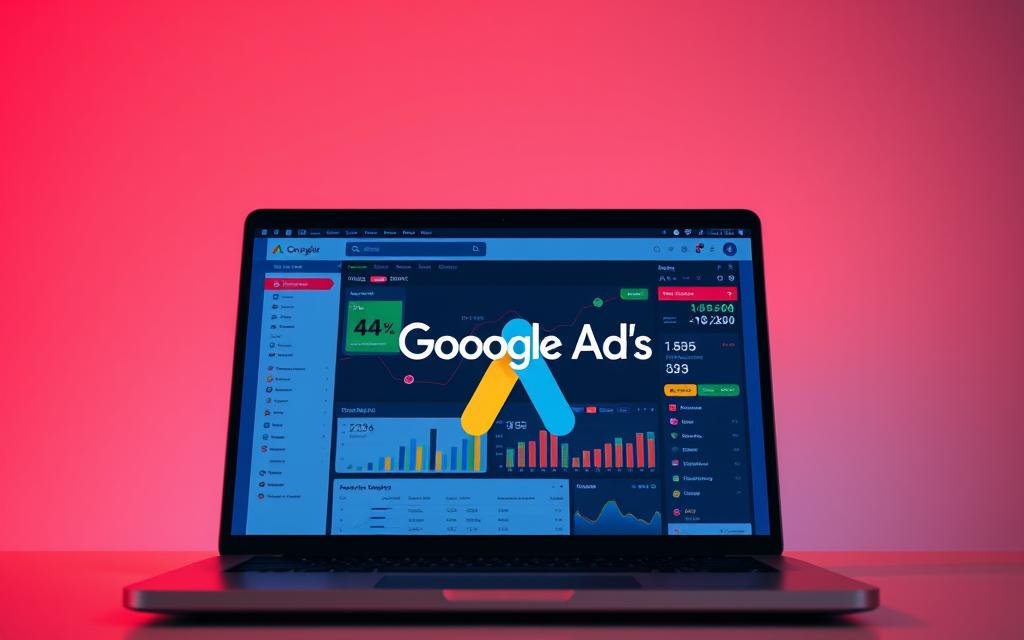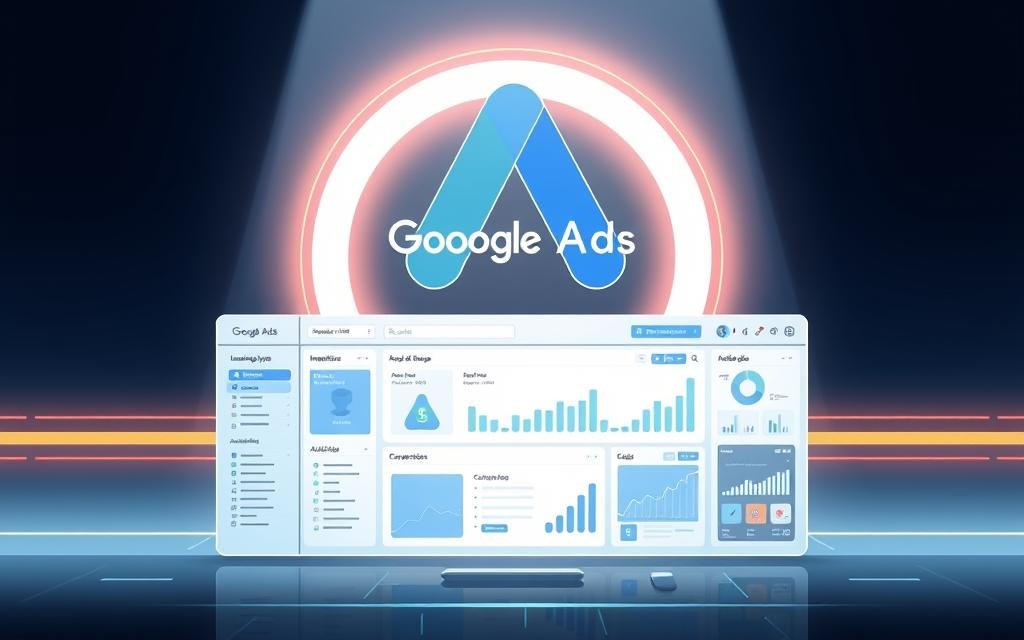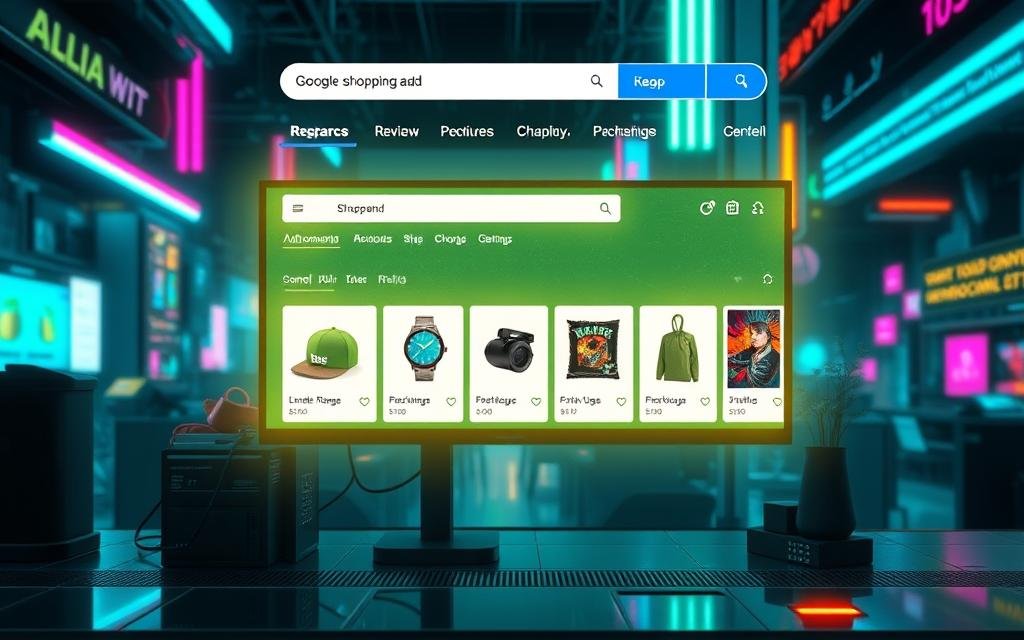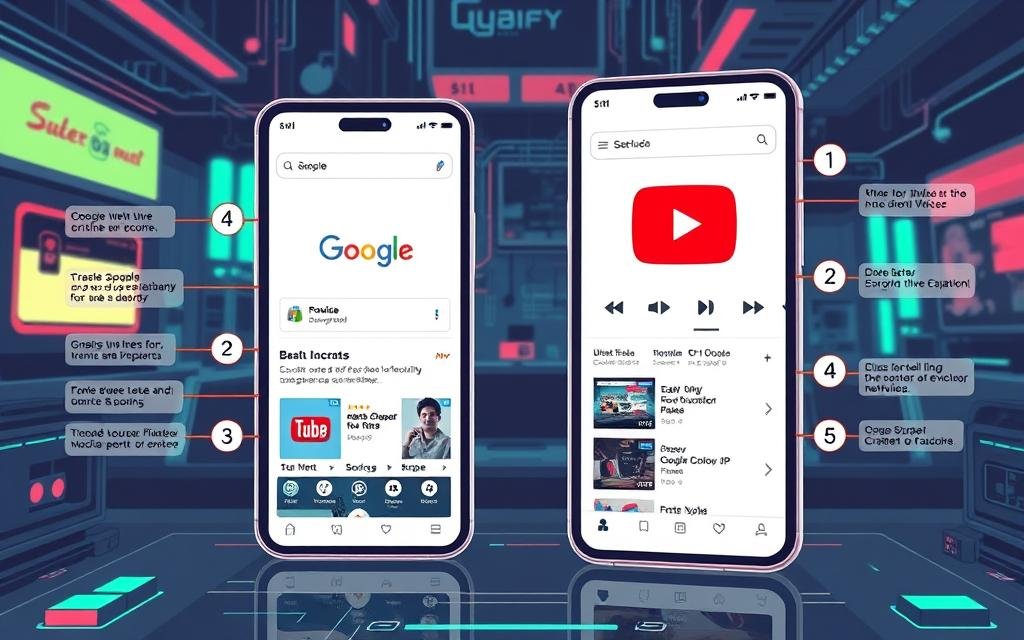In the rapidly evolving e-commerce landscape, effective advertising is crucial for the success of online stores. Did you know that advertisers spent over $65 billion on Google Ads in the last quarter of 2023 alone? This staggering figure highlights the significance of leveraging the right advertising platforms to boost visibility and sales.
We will explore how to harness the power of Google Ads to transform your Shopify store’s visibility and sales potential. By mastering strategic campaign management, you can reach potential customers at critical moments in their buying journey, significantly increasing conversion opportunities.
Our comprehensive guide is designed for both beginners and experienced advertisers, providing actionable insights to improve advertising performance and return on investment.
Understanding Google Ads for Ecommerce Success
In the realm of ecommerce, particularly for Shopify merchants, leveraging Google Ads effectively can be a game-changer. Google Ads is more than just a advertising platform; it’s a powerful tool that can significantly enhance your online visibility and drive sales.
To understand the potential of Google Ads, let’s first explore why it matters for Shopify store owners.
Why Google Ads Matter for Shopify Store Owners
Google Ads is crucial for Shopify store owners because it allows them to reach potential customers at the exact moment they’re searching for products like theirs. With 75 percent of shoppers using Google products in the past week to aid their shopping, the potential reach is vast. Google’s advertising network includes eight properties, each with over a billion users, such as YouTube, Gmail, and Google Maps. This extensive reach means your ads can appear across multiple touchpoints in a customer’s journey, increasing brand recognition and conversion opportunities.

The Power of Google’s Advertising Reach
Google’s advertising ecosystem is extraordinary in its scope and can significantly benefit your Shopify business. The platform’s ability to target users based on their search intent means you’re reaching people actively looking for products like yours. Google’s sophisticated algorithms analyze user behavior to show your ads to the most relevant audiences at the optimal time, maximizing your advertising effectiveness. By understanding and leveraging Google’s advertising reach, you can strategically position your Shopify products in front of potential customers wherever they spend their time online.
By utilizing Google Ads, Shopify store owners can tap into a vast and targeted advertising network, driving both brand awareness and sales.
Types of Google Ads Campaigns for Shopify Stores
Understanding the different types of Google Ads campaigns is essential for creating an effective advertising strategy for your Shopify store. Google Ads offers a variety of campaign types, each designed to help you achieve specific business goals.
Search Campaigns: Capturing High-Intent Customers
Search campaigns are ideal for capturing customers who are actively searching for products like yours. By targeting specific keywords, you can ensure that your ads appear in front of high-intent shoppers. This campaign type is particularly effective for driving conversions.
Shopping Campaigns: Showcasing Your Products Visually
Shopping campaigns allow you to showcase your products visually, making it easier for customers to find what they’re looking for. These campaigns are product-based, meaning you can promote specific products from your Shopify store. By using high-quality product images and competitive pricing, you can attract more customers.
Display and Discovery Campaigns: Expanding Your Reach
Display and Discovery campaigns help you expand your reach beyond search results. Display campaigns show your ads on relevant websites across the internet, while Discovery campaigns promote your products on YouTube and other Google platforms. These campaigns are great for building brand awareness and reaching new audiences.
Video Campaigns: Engaging Customers on YouTube
With over two billion monthly visitors, YouTube is a powerful platform for engaging with potential customers. Video campaigns on YouTube allow you to connect with your audience through compelling visual storytelling. You can use various ad formats, such as skippable in-stream ads or bumper ads, to achieve your marketing goals. By leveraging YouTube’s vast audience, you can drive brand awareness and conversions for your Shopify store.
Video campaigns are particularly effective for products that benefit from demonstration or emotional storytelling. You can target viewers based on their search behavior, videos they’ve watched, and channels they subscribe to, making it easier to reach your target audience.
Setting Up Your Google Merchant Center Account
To unlock the full potential of Google Ads for your ecommerce business, setting up your Google Merchant Center account is essential. This step is crucial for creating effective Shopping campaigns that showcase your products to potential customers.

Creating and Verifying Your Account
The first step in setting up your Google Merchant Center account is creating and verifying your account. This involves providing basic information about your business and verifying your email address. Verification is a critical step as it ensures the security and authenticity of your account.
Configuring Tax and Shipping Settings
After verifying your account, you’ll need to configure your tax and shipping settings. This step is vital for ensuring that your product listings comply with Google’s policies and for providing accurate information to your customers. Accurate tax and shipping information can significantly impact your customers’ shopping experience and your store’s conversion rates.
Linking Your Merchant Center to Google Ads
Linking your Google Merchant Center to your Google Ads account is a crucial step that enables you to create Shopping campaigns using your product feed. To do this, you’ll need to navigate to the Account Linking section in your Merchant Center settings and enter your 10-digit Google Ads ID along with an email address that has admin access to both accounts. This connection allows your Google Ads account to access your product information, forming the foundation for all your Shopping campaigns.
By following these steps, you’ll be able to set up your Google Merchant Center account effectively and start leveraging Google Ads to grow your Shopify store.
Building an Effective Shopify Google Ads Strategy
Crafting a successful Google Ads campaign for your Shopify store requires a well-thought-out strategy. We will guide you through the process of creating an effective campaign that drives results.
Setting Clear Campaign Objectives
Setting clear campaign objectives is the foundation of a successful Google Ads campaign. We help you define your goals, whether it’s increasing sales, generating leads, or boosting brand awareness. By establishing clear objectives, you can create targeted ads that resonate with your audience.
Determining Your Budget and ROAS Goals
Determining your budget and Return on Ad Spend (ROAS) goals is crucial for optimizing your Google Ads campaign. We recommend allocating a budget that aligns with your business goals and setting realistic ROAS targets. By doing so, you can ensure that your ads are profitable and drive meaningful results. When setting up a new campaign in Google Ads, you can group products by brand, category, custom label, or other attributes, making it easier to filter and organize your campaigns later on.

Choosing the Right Campaign Structure
Choosing the right campaign structure is vital for effective Google Ads management. We suggest organizing your campaigns by product category, profit margin, seasonality, or customer journey stage. For Shopify stores with diverse product catalogs, creating separate campaigns for different product categories allows for more precise budget allocation and performance tracking. By using ad groups effectively within your campaigns, you can group similar products or keywords, enabling more targeted ad messaging and bidding strategies.
A well-designed campaign structure is the foundation of successful Google Ads management, making it easier to allocate budget, track performance, and optimize results over time. By leveraging data and choosing the right campaign type, you can maximize your ROI on Google Ads.
Creating Powerful Google Shopping Ads for Your Shopify Products

Google Shopping Ads offer a highly effective way for Shopify merchants to showcase their products directly in Google search results. By leveraging these ads, you can increase your product visibility, drive more targeted traffic to your store, and ultimately boost sales.
Selecting the Right Campaign Type: Standard vs. Performance Max
When creating Google Shopping Ads, choosing the right campaign type is crucial. You have two primary options: Standard Shopping Campaigns and Performance Max Campaigns. Standard Shopping Campaigns allow for more control over your ad campaigns, enabling you to manage bids, targeting, and ad groups manually. On the other hand, Performance Max Campaigns utilize Google’s machine learning algorithms to optimize your ad performance across multiple channels, including Google Search, Display, YouTube, and Discover.
The choice between these campaign types depends on your specific business needs and goals. If you prefer more control and have the resources to manage complex campaigns, Standard Shopping might be the better choice. However, if you’re looking for a more automated solution that can help you reach a wider audience, Performance Max could be more effective.
Optimizing Your Product Feed for Better Results
Optimizing your product feed is critical for the success of your Google Shopping Ads. This involves ensuring that your product data is accurate, up-to-date, and optimized for relevance. High-quality product images, detailed product descriptions, and accurate pricing information are essential for making your products more appealing to potential customers.
To optimize your product feed, focus on providing detailed and accurate product information, including titles, descriptions, and images. Regularly updating your feed to reflect changes in inventory, pricing, or product specifications is also crucial.
Setting Up Local Inventory Ads for Brick-and-Mortar Stores
For Shopify merchants with physical store locations, Local Inventory Ads (LIAs) can be a powerful tool to drive foot traffic and omnichannel sales. LIAs showcase your in-store product availability to nearby shoppers on Google, displaying messages like “Pick up today.”
To set up LIAs, you’ll need to enable them in your Google Merchant Center account, create and submit a local inventory feed, request inventory verification, and then enable local inventory ads in your shopping campaigns. This process helps connect your digital advertising efforts directly to in-store sales opportunities.
Optimizing Your Shopify Google Ads Product Feed
A well-optimized product feed is the backbone of a successful Google Ads campaign for Shopify store owners. We understand that a finely tuned product feed can make all the difference in your advertising efforts, helping you reach the right customers at the right time.
Crafting Compelling Product Titles and Descriptions
Crafting compelling product titles and descriptions is crucial for capturing the attention of potential customers. We recommend including relevant keywords in your product titles to improve visibility in Google Shopping results. Your product descriptions should provide clear, concise information about the product, including its features and benefits. This not only helps with search engine optimization but also enhances the user experience, making it more likely for shoppers to click on your ads.
Selecting High-Quality Product Images
High-quality product images are essential for making a great first impression on potential customers. We suggest using clear, well-lit images that showcase your products from the best angle. This is particularly important for Google Shopping campaigns, where product images are displayed alongside competing offers. By selecting high-quality images, you can increase the likelihood of attracting clicks and driving conversions.
Using Custom Labels for Better Campaign Management
Custom labels are optional attributes in your product feed that allow you to create your own classification system for products, independent of Google’s standard categories. We can utilize these labels to group products by attributes such as brand, category, or custom labels like “Top Sellers” or “Clearance.” This flexibility enables more sophisticated campaign structures and bidding strategies, allowing you to allocate your budget more effectively based on business priorities. For instance, using custom labels to identify your best-selling or highest-margin google product lets you create dedicated campaigns with more aggressive bidding for these profitable items, ultimately enhancing your shopping campaigns and overall Google Ads performance.
By implementing these strategies, you can significantly improve the performance of your Google Ads campaigns and drive more sales through your Shopify store. Optimizing your product feed is an ongoing process, and we recommend regularly reviewing and refining your approach to stay competitive in the ever-evolving landscape of Google Shopping and Google Ads.
Mastering Bidding Strategies for Shopify Google Ads

The right bidding strategy can significantly boost the performance of your Shopify Google Ads. To achieve success, it’s crucial to understand the various bidding options available and how they can be optimized for your e-commerce business.
Understanding CPC, CPA, and ROAS Bidding
When it comes to Google Ads bidding, there are several strategies to consider. Cost Per Click (CPC) bidding involves paying each time a user clicks on your ad. Cost Per Acquisition (CPA) bidding focuses on the cost of acquiring a customer, while Return on Ad Spend (ROAS) bidding aims to maximize revenue based on the spend.
Each of these strategies has its advantages and is suited to different campaign goals. For instance, CPC is ideal for driving traffic, while ROAS is better suited for campaigns focused on conversion value.
Leveraging Smart Bidding and Automation
Smart Bidding, often used with Performance Max ads, leverages machine learning to analyze millions of signals in real-time, adjusting bids to help you meet your targets. This “auction-time bidding” adjusts bids for each shopper based on their likelihood to convert.
We will explore how Smart Bidding can transform your advertising efficiency. It uses advanced algorithms to analyze numerous signals, making adjustments that are impossible to manage manually. Various Smart Bidding strategies are available, including Target CPA, Target ROAS, Maximize Conversions, and Maximize Conversion Value.
Tracking and Measuring Your Google Ads Performance
Measuring the success of your Google Ads campaigns is essential for optimizing your advertising strategy and ensuring the best possible return on investment for your Shopify store. To achieve this, you need to track and analyze the performance of your ads effectively.
Setting Up Conversion Tracking for Your Shopify Store
Conversion tracking is a critical component of any Google Ads campaign. It allows you to measure the actions that are most valuable to your business, such as purchases, sign-ups, or downloads. To set up conversion tracking for your Shopify store, you need to create a conversion action in your Google Ads account and then add the conversion tracking code to your website. This process enables you to track conversions directly within Google Ads, providing valuable insights into your campaign’s effectiveness.
As emphasized by Google, “Conversion tracking helps you understand which ads are driving valuable customer activity.” By implementing conversion tracking, you can make informed decisions about your ad spend and campaign optimization.
Analyzing Key Performance Metrics
Once you have set up conversion tracking, you can analyze key performance metrics to evaluate and improve your Google Ads campaigns. Essential metrics to monitor include click-through rate (CTR), conversion rate, cost per conversion (CPC), and return on ad spend (ROAS). These metrics provide insights into ad relevance, landing page effectiveness, customer acquisition costs, and overall campaign profitability.
- CTR: Measures ad relevance and appeal.
- Conversion Rate: Tracks the percentage of visitors who complete a desired action.
- CPC: Calculates the cost of acquiring each customer.
- ROAS: Measures revenue generated per dollar spent on advertising.
By analyzing these metrics, you can identify areas for improvement and make data-driven decisions to optimize your campaigns. As noted by industry experts, “Regular analysis of performance metrics is crucial for campaign optimization and achieving a better ROI.”
Integrating Google Ads with Your Shopify Store Using Apps
Integrating Google Ads with your Shopify store can be streamlined with the right applications, enhancing your advertising capabilities. We explore how various apps can simplify this process and improve your advertising efforts.

The Google & YouTube App for Shopify
The Google & YouTube app for Shopify provides a foundational integration for managing Google Ads directly within your Shopify dashboard. This official app allows for easy linking of your Google Ads account, enabling you to create and manage campaigns more efficiently. With this app, you can synchronize your product data and leverage Google’s advertising capabilities to reach a broader audience.
Third-Party Apps for Enhanced Google Ads Management
Beyond the official Google & YouTube app, several third-party apps offer advanced features for Google Ads management. Apps like DataFeedWatch, GoDataFeed, and Feedonomics specialize in feed management, providing tools for bulk editing, custom field mapping, and automated title optimization. These apps are particularly useful for merchants with larger inventories, helping to optimize product data before it reaches Google. Additionally, there are apps focused on conversion tracking and analytics, as well as multi-channel advertising management, which can further enhance your advertising strategy.
Conclusion: Taking Your Shopify Store to New Heights with Google Ads
As we conclude our comprehensive guide on mastering Shopify Google Ads, it’s clear that the right strategies can significantly boost your ecommerce success. We’ve covered essential techniques for leveraging Google Ads to drive growth in today’s competitive landscape.
Key takeaways include understanding the various campaign types and selecting the right mix for your business goals, whether focused on sales, brand awareness, or customer acquisition. A well-optimized product feed is crucial for effective Shopping campaigns.
By implementing strategic bidding approaches, such as Smart Bidding, and integrating Google Ads with your Shopify store through official and third-party apps, you can create a seamless advertising ecosystem. We encourage you to start implementing these strategies today, beginning with the fundamentals and gradually incorporating more advanced techniques as you gain experience.

I just like the helpful information you provide in your articles
Worth every upvote.